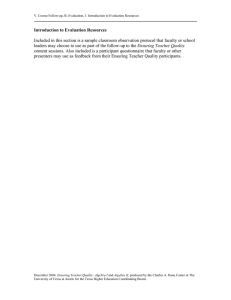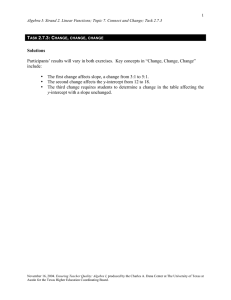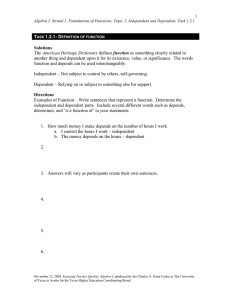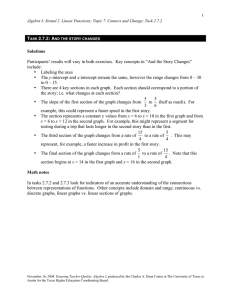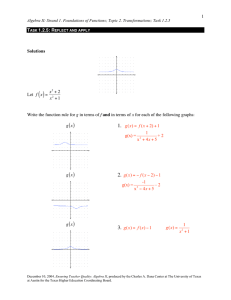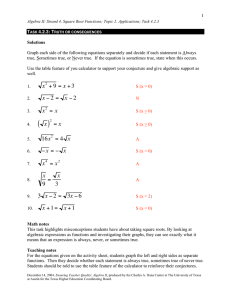1 You are a member of an engineering team that is... engineers have determined that the optimum shape for the exhaust...
advertisement
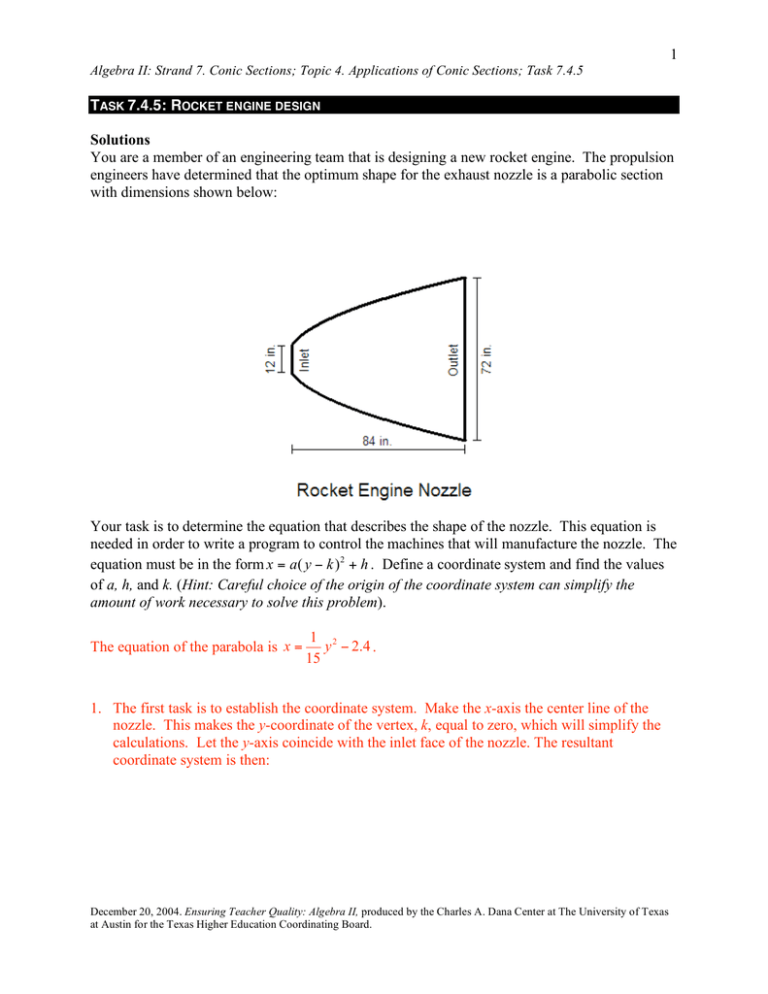
1 Algebra II: Strand 7. Conic Sections; Topic 4. Applications of Conic Sections; Task 7.4.5 TASK 7.4.5: ROCKET ENGINE DESIGN Solutions You are a member of an engineering team that is designing a new rocket engine. The propulsion engineers have determined that the optimum shape for the exhaust nozzle is a parabolic section with dimensions shown below: Your task is to determine the equation that describes the shape of the nozzle. This equation is needed in order to write a program to control the machines that will manufacture the nozzle. The equation must be in the form x = a( y ! k)2 + h . Define a coordinate system and find the values of a, h, and k. (Hint: Careful choice of the origin of the coordinate system can simplify the amount of work necessary to solve this problem). The equation of the parabola is x = 1 2 y ! 2.4 . 15 1. The first task is to establish the coordinate system. Make the x-axis the center line of the nozzle. This makes the y-coordinate of the vertex, k, equal to zero, which will simplify the calculations. Let the y-axis coincide with the inlet face of the nozzle. The resultant coordinate system is then: December 20, 2004. Ensuring Teacher Quality: Algebra II, produced by the Charles A. Dana Center at The University of Texas at Austin for the Texas Higher Education Coordinating Board. 2 Algebra II: Strand 7. Conic Sections; Topic 4. Applications of Conic Sections; Task 7.4.5 2. We now can establish the coordinates of four points on the parabola. This is more than sufficient to define the parabola. These points are shown above. 3. In order to find the values of a and h, we must write a system of two simultaneous equations. Using the equation x = a ( y ! k ) 2 + h , substitute the coordinates of two points: 0 = a (6 ! 0) 2 + h 84 = a (36 ! 0) 2 + h Simplifying and rearranging, we can write 36a + h = 0 1296a + h = 84 4. We can write this system in matrix form and use the graphing calculator to solve the system. The easiest method is to enter the augmented matrix and use the reduced row-echelon function of the calculator. The augmented matrix is: ! 36 1 0 " #1296 1 84 $ % & December 20, 2004. Ensuring Teacher Quality: Algebra II, produced by the Charles A. Dana Center at The University of Texas at Austin for the Texas Higher Education Coordinating Board. 3 Algebra II: Strand 7. Conic Sections; Topic 4. Applications of Conic Sections; Task 7.4.5 Enter this matrix in the calculator as: (In this case the matrix is named B) Use the rref( function which is found under MATRIX, MATH, B. Enter the matrix name and close parenthesis. Press ENTER: The solution is a = 0.066 and h = -2.4. Writing a as a fraction, a = The equation of the parabola is x = 2 1 = . 30 15 1 2 y ! 2.4 15 Another approach would be to enter the coordinates in the graphing calculator and then use quadratic regression to find the equation. However, this requires orienting the nozzle so that the center line coincides with the y-axis rather than the x-axis, finding the equation, and then changing it into the required form of x = a ( y ! k ) 2 + h . This approach is as follows: 1. Define the coordinate system as: December 20, 2004. Ensuring Teacher Quality: Algebra II, produced by the Charles A. Dana Center at The University of Texas at Austin for the Texas Higher Education Coordinating Board. 4 Algebra II: Strand 7. Conic Sections; Topic 4. Applications of Conic Sections; Task 7.4.5 2. Enter the coordinates in L1 and L2. Press STAT, then ENTER: 3. Use the STAT CALC feature to find the regression equation. Press STAT, right arrow to CALC, and choose 5:QuadReg: 4. Press ENTER and then enter the lists where the x and y coordinates of the data are stored. For L1, press 2nd, 1. For L2, press 2nd, 2. Point out to students that these are the default lists for regression calculations. It is not necessary to enter L1 and L2; however, it is good practice to always enter the lists. If they get in the habit of specifying the lists, then they will be less likely to inadvertently use data in L1 and L2 when their data is actually stored in other lists (L3-L6). 5. Press ENTER. December 20, 2004. Ensuring Teacher Quality: Algebra II, produced by the Charles A. Dana Center at The University of Texas at Austin for the Texas Higher Education Coordinating Board. 5 Algebra II: Strand 7. Conic Sections; Topic 4. Applications of Conic Sections; Task 7.4.5 If DiagnosticON is selected (found under CATALOG (2nd, 0)), then the R2 term (coefficient of determination) will appear. This is a measure of the closeness of the fit of the regression equation to the data. If R2 = 1, then the calculated equation fits the data exactly. If DiagnosticOff is selected (this is the default), then the R2 will not appear. From this screen, the equation is y = .06 x ! 2.4 . Converting the repeating decimal to a 1 fraction, we can write y = x 2 ! 2.4 . 15 6. Our result is in the form y = a ( x ! h) 2 + k . The last step in the solution process is to write the equation in the form x = a ( y ! k ) 2 + h . Using patty paper or a transparency, students can copy the graph and then rotate it 90 degrees in the clockwise direction to match the original drawing. From this rotated image, they should be able to write the equation as 1 x = y 2 ! 2.4 . 15 These are two approaches that arrive at the same solution. Other solutions are possible, depending upon the choice of the coordinate system. Teaching notes See the solution to this problem for the teaching notes. Many are embedded within the solution. This would be a good problem to assign in groups. Circulate among the groups and find those groups who are using different strategies to solve the problem. Have these groups put their work on posters and present to the class. December 20, 2004. Ensuring Teacher Quality: Algebra II, produced by the Charles A. Dana Center at The University of Texas at Austin for the Texas Higher Education Coordinating Board. 6 Algebra II: Strand 7. Conic Sections; Topic 4. Applications of Conic Sections; Task 7.4.5 TASK 7.4.5: ROCKET ENGINE DESIGN You are a member of an engineering team that is designing a new rocket engine. The propulsion engineers have determined that the optimum shape for the exhaust nozzle is a parabolic section with dimensions shown below: Your task is to determine the equation that describes the shape of the nozzle. This equation is needed in order to write a program to control the machines that will manufacture the nozzle. The equation must be in the form x = a( y ! k)2 + h . Define a coordinate system and find the values of a, h, and k. (Hint: Careful choice of the origin of the coordinate system can simplify the amount of work necessary to solve this problem). December 20, 2004. Ensuring Teacher Quality: Algebra II, produced by the Charles A. Dana Center at The University of Texas at Austin for the Texas Higher Education Coordinating Board.
